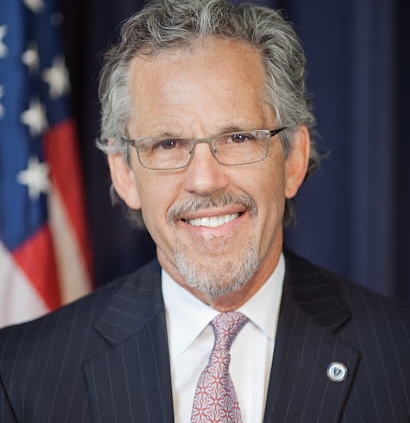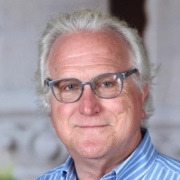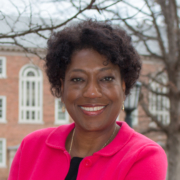Ever since the 1983 Nation at Risk report, America has seemingly gone through one educational reform after another. Have these reforms worked? My guest today, Paul Reville, thinks the reforms have correctly focused on the goals of excellence and equity but have not addressed the systemic problems impacting schools.
Paul Reville is the founding director of the Education Redesign Lab at the Harvard. Prior to his time at Harvard, he was the Education Secretary for the Commonwealth of Massachusetts. As Governor Patrick’s top education adviser, Paul brings valuable insights to his work of the real-life political challenges that sometimes slow educational change.
Paul is the Francis Keppel Professor of Practice of Educational Policy and Administration at the Harvard Graduate School of Education.
Citation: Reville, Paul, interview with Will Brehm, FreshEd, 96, podcast audio, November 20, 2017. https://www.freshedpodcast.com/paulreville/
Transcript, translation, resources:
Will Brehm 1:56
Paul Reville, welcome to FreshEd.
Paul Reville 1:57
Thank you, Will. Good to be here.
Will Brehm 2:00
Since ending your tenure as the Massachusetts Secretary of Education in 2013, you have returned to the Harvard Graduate School of Education to spearhead what is called the Education Redesign Lab. In your opinion, what needs redesigning in education?
Paul Reville 2:21
Well, the reason I launched this new effort called the Education Redesign Lab was that while I was very proud of what we’ve accomplished in Massachusetts in terms of boosting student achievement, closing achievement gaps, moving this state to first in the nation in terms of student achievement – and when you compare Massachusetts with other jurisdictions around the world, we’re at or near the top in most categories of student achievement. So we had a lot to be proud of, but when you dig down into those results, you see that those first place finishes are based largely on averages and within those averages are deep, persistent achievement gaps, the like of which we set out to close now 25 years ago when we embarked on education reform in Massachusetts and we haven’t gotten there. So, the Education Redesign Lab is really designed to think about, “Why didn’t we get there?” And to ask questions, like, “Were our goals, right?” We had the goal of “all means all” – educating all children to high levels. I think that’s still a relevant and important goal, both in a moral sense – ethically, that’s what we ought to do for the next generation – and in a practical sense. If we want to grow our economy, if we want to avoid the rapid development of an underclass that cannot participate in that economy, then we need to educate all of our students to a high level. So, to answer the question, “Were the goals, right?”, I think the goals were absolutely right. Second question we ask is, “Were the methods and means of reform that we and other states around the US embarked on appropriate strategies for improving student learning?” And I think the answer there is, “Yes, they were appropriate, they were necessary, but they weren’t sufficient.” Because the results tell us that not only in Massachusetts, but all across the country, we have these same kinds of enormous achievement gaps where some of our students are doing quite well and others are doing poorly. In fact, in Massachusetts, we have some of the largest gaps in the nation. But the fact that we focused on having standards, measuring progress, holding people accountable, introducing choice to a monopolistic system, focus on the use of data and on how we improve teaching, dealing with chronically underperforming schools, all of these were appropriate strategies for upgrading our investment in public education in the United States. So we needed to do those things, but now the results are in and the results show us it wasn’t sufficient to get us anywhere near “all means all”, which is what we set as our policy objectives, both at the state level and at the national level. So, the last question we ask, and this comes in a long way to an answer to your question, Will, which is, “What do we need to redesign?” It’s the system. The system is the problem. We inherited a delivery system from the early 20th century that wasn’t built to deliver on a promise of “all means all”. It was designed in the early 20th century when we had large numbers of immigrants coming into the cities from abroad, from the countryside. We needed to batch process, mass produced education that would rapidly socialize them and move them into low skill, low knowledge, routine manufacturing jobs in a growing factory economy. That system worked pretty well. We only needed a 10% graduation rate, for example. And throughout the 20th century, we stuck with that factory model system. We refined it. We added a kindergarten. We added a middle school. We increased the graduation rate from 10% up to 70 and 80% in some places now. But the standard dropped down in terms of what we expected in terms of graduation. We came up with new governance systems and finance systems. We built state Departments of Education and so on and so forth. But the net result in the end was, by the time we hit the late ’80s and the 1990s in this country, both governors and business people looked around and said, “We don’t have a human capital system that’s producing large numbers of people who can do high skill, high knowledge jobs, and we need to redesign that human capital development system in a way that produces that result: that all of our children get prepared to have successful careers in high skill, high knowledge occupations. And that will take a fundamental redesign of the system, not just an improvement to schooling. And we have this kind of myth in our country that if we just get schools right, that schools will be the great – as Horace Mann said – “the great balance wheel in society”; that that will create a situation in which we have a meritocracy. While that was a radical and important idea in Horace Mann’s time in the 19th century: that we create a common school, have everybody irrespective of race, or creed or social class or ethnicity, go to a school. That was a first step in creating an equal opportunity society. But now with the vast inequalities outside of school, and don’t forget, in the K-12 span of a child’s life, only 20% of their hours are spent in school; 80% are spent out. We have growing inequalities, access to support and opportunities outside of school. And school can’t make up for that on average. And so, what we need to do is look at the system and redesign that system to be more effective.
Will Brehm 7:53
And what would this system begin to look like in your mind?
Paul Reville 7:56
Well, that’s part of the work that we do here. I think of it as a new engine for the development of human capital in our society. So, we’ve been working with this Model T engine. It was designed to go about 30 miles an hour in the early 20th century. Now we’re in an era where we need an engine that goes a hundred, 120 miles an hour. We have tinkered with and modified the existing engine, and we got it up to maybe 50 miles an hour, maybe 55. But nowhere near the speed that it needs to go in order to drive economic development and prosperity in our society in the 21st century. So, we don’t know exactly what it looks like in all humility. That’s what we set up the lab to do. We are deliberately in the university context, a laboratory for reinventing the design of how we do child development and education in the United States. And we have laboratories. We’re working with half a dozen cities and one state across the country. We start with three design principles, Will. One is the notion of personalization – that one of the problems with our existing system is that it has a one size fits all basic assumption as a factory would. You have raw material. It’s all basically the same raw material. You bring it into the factory, in this case, the school. You give it the same treatment, at best. And then it comes out at the other end and you get basically the same result for everyone. But we’ve got mountains of data to show that that just isn’t working. That paradigm does not speak to the realities of children’s lives and education. Children coming into school are not all the same. We know from research, for example, that children of professional class families have typically heard about 50 million more words than children from welfare families when they start kindergarten. We also know from research that there’s about a five-year spread in terms of reading readiness and grade level when people enter kindergarten. And if you divide those children in quintiles from those who are two or three years behind to those who are two or three years ahead, what you find is through the 13 years of K-12 education, they basically stay in those quintiles, stay in those cohorts, without moving. So, in a certain sense, the battle is over before it even begins. So, principle number one in our design work is: it’s got to be a personalized system. It has to meet every child where he or she is in early childhood, give them what they need inside and outside of school in order to be successful so that they can traverse the entire trajectory from birth through some post-secondary education, and emerge meeting what we think of are the top four most important goals for education: 1) you ought to be able to get and hold of 21st century high skill, high knowledge job that enables you to support yourself and a family; number 2) you should be able to be an active, informed citizen, and a leader should you choose to do so in a democracy; number 3) you need to be capable of becoming head of a family if you choose to move in that direction, with all the character traits and values we associate with that; and finally, you need to be a lifelong learner capable of solving problems that we as educators can’t even imagine today. So that’s the first and most important principle, is it needs to be a design system that’s personalized and meets every child where they are, gives them what they need inside and outside of school. Two other elements that are important to personalization, but we choose to highlight as design principles, are: number 1) that it be a system which integrates health and social services; that we attack the impediments that get in the way of young people coming to school in the first place and being able to supply their best motivated effort when they get there. So, we need a system that gives all children access to quality health care, mental health services, housing stability, you know, family safety, nutrition, etc. The kinds of things that upper middle class and upper-class children take for granted turn out to be prerequisites for high quality learning when you get the school. Turn out to matter as to whether you even get to school in the first place. We can reform schools till the cows come home, but if the kids aren’t there, or aren’t capable of concentrating due to life circumstances outside of school, all the school reform in the world isn’t going to make a difference. So, having integrated systems of health and human services are really important. The third thing, the third element here – we’ve got personalization, integrated services, and the third is – leveling the playing field with respect to access to out of school learning. So, children from affluent backgrounds have access to virtually 24/7 opportunities for enrichment of various kinds, ranging from camps to summer, to early childhood, to technology, to being read to, to travel, to foreign languages, on and on, music lessons, you name it. It’s constantly. They’re learning in a way other than school, and that learning turns out to matter every bit as much as schooling in terms of the things that we measure in school. But we discount it, we act as though it’s incidental, it’s an accident of birth, whether they get access to that or not. So, what we’re saying is that if we really want to get to “all means all”, we’ve got to give disadvantaged children just as much access to enrichment opportunities outside of school as other children have. In short, you know, Will, we want to do for all children, in our design work, what those of us who have privilege are able to do for our own children.
Will Brehm 13:56
If you could go back in time to when you were the Massachusetts Secretary of Education, would you have approached some of the legislative issues that crossed your desk differently now having learned through this Redesign Lab?
Paul Reville 14:12
You know, I think there are things that I would have pushed harder. Of course, anytime you’re working in government, you’re working with a variety of constraints. So, you’re working for a particular governor, the governor has his particular ideas about what we need to do in education, he also is responsible for virtually everything else that happens at the state level. So, you have only so much political capital you can use and only so much time you’re in office. So, you have that. Then you have the legislature; it has its own interests. It is highly susceptible to all kinds of outside interest groups. So, you’re constrained. One of my big lessons being in government was learning all the constraints that pertain to people who are in positions of power, who from the outside world look like they can simply accomplish whatever they want by virtue of fiat. But when you actually get in there, your hands are tied on many kinds of issues so it’s difficult to move. So, we attempted to move some of these kinds of issues that we’re talking about today. It isn’t as though we hadn’t thought of these things, or weren’t aware, or didn’t try to move them. For example, in our Race to the Top application, Massachusetts had the top scoring application in the country, and we got a major Race to the Top grant. There was provision in there to pay attention to these set of issues and to create communities and boards within communities that took a more holistic look at the needs of children. We made provisions in our Achievement Gap Act of 2010, which was the major piece of education legislation we passed during Governor Patrick’s term and my time in office. And in that we insisted, and when we looked at school turnaround efforts that, for example, the Secretary of Health and Human Services and her operation would be at the table in designing solutions for chronically underperforming schools. So, we did accomplish some things. Would I liked to have accomplished more? Absolutely. On the other hand, there is a kind of resistance in the world of education to addressing these problems first and foremost, for a variety of reasons. The impact of poverty has been systematically underestimated. We don’t want to look straight at the vast inequality that exists in the lives of children and makes the job of schools actually much more difficult. And so, you have educators who think that if we focus on the background of kids, we’re making excuses. So, we have a whole category of schools in education now that like to call themselves “no excuses schools”. And we have educators that think it diminishes the importance of education; this dates all the way back to the Coleman report, in which Coleman found that family background was the most powerful predictor of educational success. And it’s still the case today – we have an iron law correlation between socioeconomic status at birth and of your family, and educational achievement and attainment. And all of our reform efforts were designed to undo that. But it’s an absolutely straight-line correlation. So, the question is, what do we do about that? Another problem that educators perceive in this area, is that they don’t really have the tools to deal with it. In other words, this isn’t strictly a school problem. My contention in the work that we’re doing is schools alone, as currently constituted, are simply insufficient to achieving the goal of “all means all”. It’s going to take a much broader, community wide effort, which is why in our work in the Education Redesign Lab and an initiative we have called, “By All Means”, we start with picking mayors who have this kind of a vision – in effect a new social compact between them and their communities – they recognize that their communities cannot be successful unless the children coming up in that community are ultimately successful themselves. And that in order to assure children success in college and career, you have to do more than simply provide a quality school system. And so, our mayors are committed to doing this kind of design work with us: figuring out the messy business of how do you build a Children’s cabinet, and interconnect the Health and Human Services domain with the Education domain. Interconnect much more visibly, the world of Housing and the world of Education, of Criminal Justice and Education. Figuring out, how are we going to make access to summer learning opportunities not just an accident of birth? If you happen to be born into a family that’s going to send you to camp or send you abroad or give you music lessons all summer, good for you and if you don’t, too bad. But instead saying, “We can see from the research that kids who have these kinds of learning opportunities surge forward in their academic lives, those who don’t fall back, and therefore we’re going to make it an entitlement.” But how do we do that? How do we make it practical? How do we pay for it? How do we get people signed up to do it? For whom are we going to make it an entitlement? And so on and so forth. So our mayors are working in these cities all across the country: Oakland; Louisville, Kentucky; Providence, Rhode Island; and three cities – Somerville, Salem, and Newton – here in Massachusetts, have committed themselves to doing the design work to try and figure out what it actually looks like to create systems of opportunity and support to complement a personalized education system in order to meet this larger goal of meeting kids where they are and giving them what they need to be successful. Much as parents in an affluent family do when they look at their children and they think in a 360-degree modality about “What does this child need to be happy, healthy, have friends, be successful in school, etc?”
Will Brehm 20:32
It’s interesting. So, you come from the world of academics, but also you have had great experience in American politics. And you mentioned this notion that there are these constraints that limit even what people that are perceived to be very powerful can actually do. So, in your time in the political structures, particularly in Massachusetts, what sort of tips, or what would you recommend as ways to overcome some of those constraints that you witnessed?
Paul Reville 21:07
Well, I think there are a number of things that are important. Number one, you’ve got to set priorities. Because while all of us have many ideas about what might be done by government to improve the quality of life in our respective communities, you have a limited time to exercise whatever power you have, take advantage of whatever political capital you have. So, you have to decide what your focus is going to be. Second, you’ve got to develop the capacity to work effectively with other people. Because it’s all about collaboration. It is not about some messianic version of what needs to happen that somebody comes in and promulgates. We live in a democracy and there are multiple interests, and we have a political process to reconcile the different interests. Most people agree on, for example, the goals of education as I described them. What they disagree on is how to achieve those goals, and they disagree violently about how to do that. So, doing reform, for example, with the field as opposed to to the field is an important approach to take here. Listening. Developing coalitions and partnerships to getting the work done. All of that, I think, is vitally important, as are the interpersonal skills that go along with just building relationships of trust that enable you to move the work forward. And then finally, I’d say, having your work be informed by evidence, being willing to change your perspective based on what you learn as you move forward in doing the work, and not being rigid, ideological, or fixated on a particular solution. But understanding the problem as thoroughly as you can, continuing to develop your understanding of the problem, and then scanning deeply the evidence that suggests what can be done about solving the problem. And then being willing to modify your proposed solutions as you learn more in the process; it’s a learning process.
Will Brehm 23:18
In your experience, is there an example of when you changed your mind based on evidence?
Paul Reville 23:27
Way back in my career, for example, and in a variety of continuing controversies, but let me take a simple one. So, something that is easy to grab onto when you’re in the public space is the idea of class size. So many political figures … this has never been a big focus of mine, but I remember entertaining the idea at least. As a parent, I like it when my child has smaller classes. It feels like she’s going to get more attention, and that in general feels like a good thing. And I’ve seen a number of political figures latch on to that idea: let’s reduce class size. And yet, when I delve into the evidence about class size, as long as you’re in a reasonable range – 15 to the high 20s – the differences or the impact that lower class size makes on measurable learning is basically not discernible, except in a few very particular categories: low income youngsters in the very early primary grades. And on top of that, it’s a very expensive reform. If you reduce class sizes – some states like Florida and California have done – you spend a lot of money on more teachers and more space, money that could be used for more effective reforms. So, that’s an example of something that is easy to grab on to – the notion of class size reduction – because it’s popular with parents, but when you take a look at the evidence, it suggests maybe that isn’t the best way to go. Likewise, here’s a more recent issue: you might think that we want everybody to graduate from high school, because high school is just the minimum required entry credential to the workforce these days. It used to be, in the ’70s, even the early ’80s of the last century, you could drop out of school, go to work on an assembly line, and earn a very decent middle-class life as a factory worker. And still only have been an eighth or ninth grade dropout. Those jobs have completely disappeared, so now we say in this kind of economy, you’ve got to have high skills, high knowledge, you’ve got to have at least a high school degree. And therefore, we should have policies in our states that insist that everybody stay in school at least to the age at which you’d normally be expected to get such a diploma, which would be roughly 18. So, we’ve had a lot states say, “We’re going to move our mandatory attendance rate up to age 18”. And on the face of it, that sounds like a good idea. I might be interested in that. At one time, I was interested in that. And then I looked at the research, and the research suggests that if you simply raise the age, but you don’t do anything to change the process of education for those people who are dropping out at age 16, you simply mandate and require that they stay at a school that they didn’t want to stay in in the first place, you don’t get improved graduation rates. So if you’re going to raise the age, you absolutely have to develop kind of a parallel education program that will assure that those people who you’re mandating to stay in school actually have a different approach to education than the one that had failed with them previously. And so that began to inform my view about policies that on the face of it seemed to make sense – raise the age – but when you looked at it, raising the age alone by itself just wasn’t an effective policy.
Will Brehm 27:10
When did you get involved in the field of education? Where did you get involved, at what level?
Paul Reville 27:17
I was always involved. I was an activist. I grew up in the ’60s. I was interested in civil rights and opposed the war in Vietnam. And I went to college in a very military town in Colorado Springs in Colorado. And I began to volunteer in public schools there, and at a boys’ ranch that dealt with delinquent kids. So I got interested at that stage, and then immediately when I got out of college, I went into Vista, which was like AmeriCorps is now, and I worked in a community right near here in Somerville, Mass, as a street worker in a housing project and in the surrounding neighborhood of lots of low income kids who were dropping out of school. And what we decided to do as a team of street workers was form an alternative high school. And that’s when I first really rolled up my sleeves and got involved in the work. And then I decided, “I’m going to make a career in this”. And then I went back to graduate school, and decided to learn something, because I’d never taken an education course; I didn’t really have much grounding in the field. And from that time forward, I went to work on issues of equity in education.
Will Brehm 28:32
In your time in the alternative school that you help set up, today is there anything that you still think about that makes you act a certain way?
Paul Reville 28:43
Well, number one, it’s cause for humility. Because when you’re that young and the problems are that pressing, and you look at the society around us at the time, which was really in a downward spiral because of a very divisive society at the time, and all the disagreement about the war and things of that nature, we had a tendency to be kind of sophomoric. In other words, we thought as youth workers, as street workers, we knew exactly what needed to happen. And there were a number of ways in which we developed the school that were naive and idealistic. And we learned from failures there. Number one, to have humility, and number two, to listen and observe more closely. Number three, to get some real knowledge about not only the people we are working with, but the environment we were working in, and the tools with which you could actually use to bring about change. So, I think humility was an important early lesson to learn in my career.
Will Brehm 29:57
Are there are alternative schools today in America?
Paul Reville 30:01
Yes, there are. I think there’s a growing network of alternative schools, particularly at the high school level. For example, when I was Secretary of Education, one of the things I used to say is, “The biggest problem we have in secondary schools in Massachusetts is boredom.” We have a lot of kids who are not engaged in what they’re doing; they’re shuffling through the motions in what’s basically a compliance exercise. They have no idea why they’re studying what they’re studying. We have a group of maybe 15, 20% at the top who are furiously competing to get into the top colleges. And so, they’re not really asking the questions, they’re just doing what they need to do to get in. And then we have other kids at the other end of the spectrum who have special needs and are getting those attended to, but you know, the 70 or so percent of people in the middle – not exactly sure why they’re doing what they’re doing. And increasingly, I think school systems are looking at, “Well, what do we do with that population?” So, we’re getting a lot more focus on careers now, and alternative pathways to college and career. Starting college earlier. Doing applied learning, beginning in the eighth grade. Doing more internships. Doing more project-based learning, where kids are actually solving problems using tools like mathematical tools, like geometry, or algebra or calculus, but using them to solve real world problems so that the learning of those skills seems relevant, important and motivating. So, I think that we’re seeing a renaissance of that kind of education. Of course, throughout the K-12 system, now we had through their charter school and choice movement, an opening up of an array of different kinds of options, different approaches to schools. Some of those have been, simply, what we’ve always regarded as basic education put on steroids. Others have been genuinely different kinds of approaches to the way in which we do learning. But I think in general, there’s a growing dissatisfaction, particularly in this high tech age where young people are learning a lot just from their phones and their interactions with one another through technology, that school is in danger of becoming obsolete unless we start to think differently about how we spend this time and relationship with one another in schools. It’s important to say that schools aren’t just educational institutions, they’re daycare institutions, and very popular as such, and people need them in order to be able to go to work. They’re also employment institutions in their respective communities, and in many of our communities in the US, they’re the biggest employers in town. So, it’s hard to change schools, because if they serve a lot of purposes. And it’s one of the reasons that schools look a lot today in the 21st century like they did in the early 20th century. Whereas pretty much everything else has changed in our lives, if you look at the typical classroom, and you look at the typical classroom in the early 20th century, they’re not that different right now. And so, it’s hard to change in this domain, but it’s something that I think we’re going to have to come to grips with.
Will Brehm 33:19
Well, Paul Reville, thanks so much for joining FreshEd. It really was a pleasure to talk today.
Paul Reville 33:22
Will, I enjoyed our conversation. Thank you for giving me the opportunity to talk with you.
The Education Redesign Lab










